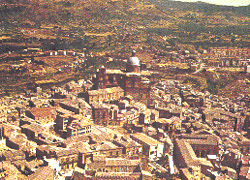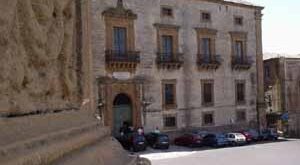 Piazza Armerina dominata dal castello Aragonese, è divenuta famosa in tutto il mondo per la Villa Romana del Casale, è circondata da boschi, ed ha conservato intatto il suo centro storico.
Piazza Armerina dominata dal castello Aragonese, è divenuta famosa in tutto il mondo per la Villa Romana del Casale, è circondata da boschi, ed ha conservato intatto il suo centro storico.
Ravvivato da verdi giardini, esso è arricchito da antichi monumenti come il Duomo del 1600, costruito sui ruderi di una chiesa più antica, col Museo Diocesano che custodisce il tesoro oltre a paramenti e statue di cera, la chiesa barocca di San Rocco, col portale di tufo intagliato, i numerosi palazzi nobiliar, il Municipio, la chiesa di San Giovanni Evangelista, il Priorato di S. Andrea, di chiaro carattere normanno, la Commenda dei Cavalieri di Malta, di grande pregio per l’armonia della struttura, la Torre del Carmine, mirabile per la purezza delle linee architettoniche e Palazzo Trigona.
2006 – Video città di Piazza Armerina
On the Erei mountains, not far from Enna is Piazza Armenia easily reached by coming off the A19 Catania Palermo motorway slip-road at Enna. Situated on three hills, the town is dominated by the “Castello Aragonese”, built by Martino I, king of Sicily, towards the end of 1300’s, and by the Duomo, dedicated to Mary of the Assumption, dating back to the 1600′, which stands on the remains of a more ancient church, In the Duomo, hangs a painting of the Madonna which was apparently donated to the grand Count Ruggero by Pope Niccolò II, a double-faced crucifix, an interesting and unique work by the so-called “maestro della croce”, and the “Assunta” by Filippo Paladino.The diocesan museum holds the treasure of the Duomo and other precious pieces, such as paraments and wax statues. The old town centre is an interesting succession of noble palaces easily observed as you proceed through the characteristic medieval streets. Worth seeing is the gate in carved tuff of the baroque church of San Rocco, as well as the frescoed ceiling of the town palace, and the Borremans frescoes in the church of San Giovanni Evangelista. On the outskirts of the town, the ancient church priory of San Andrea, founded by a nephew of Ruggero I in 1096, is worth visiting. Heading out of the town towards Valguarnera, it is also worth stopping off at the Ronza Park, a well equipped and vast green area run by the Forestry Commission, with numerous animal species.
Built for will of King Martino I° of Aragon in 1392, it rises on a hillock situated on the southern side of the ancient part of the inhabited centre. Its towers, encircled by bastions and rivellini, have accommodated for a long time the civil condemned. Structure of great interest, the castle possess a characteristic planimetry: four square towers connected by fortified walls with trapezoidal system. Little time ago it has been given back to the communal administration that intends using it for touristic purpose. We do not have news about the exact place where the ancient city of Piazza Armerina rose. Anyway it goes back to the Greek colonization time. One kilometre away from Piazza Armerina there are S. Francesco’s convent ruins. It belonged to the ancient Castrum Armorum, going back to Conte Ruggero’s age. Still clearly visible in the historical centre of Piazza Armerina are the Tower of S. Giovanni’s place, the Catalan Door, the Castellana Door and rests of the ancient Castle fortifications on which has developed the present urban nucleus. Along the Barrafranca – Piazza Armerina road is collocated the March Mountain. It surely was a fortified city of remarkable extension. From the excavations carried out we suppose his foundation goes back to the IV century bC. Nowadays remain just the rests of the town-walls, probably built as defence from the Greek invasion. But excavations here brought to light also walls and buildings of Greek, roman and Byzantine origin. On the same territory the ruins of several fortified “masserie” (ancient farms) are recovered.
The construction of the cathedral of PiazzaArmerina started from 1604, thanks to Orazio Torriani, on the top of the high of the three hills which dominated the historical centre of the town. Upon the chosen place there was a catalan gothic church dating from the first half of the fifteenth century. The only memory of this building are the couples of windows with inflex arch and vegetables ornaments upon the left side of the bell-tower which was furnished of the superior side during 1526. The style of the church front prove the import in Sicily of the typical roman model of the everlasting city. Inside the building, on the left side , there is a marble tomb of the late renaissance that shelter the mortal remains of Laura De Asaro died in 1597. The most fascinating and precious work of the Cathedral is a crucifix painted on wood, on both the faces, assigned to a so-called Master of the crucifix of PiazzaArmerina. The high altar, with the refined play of marbles and hard stones, is of neo-classic style, of the seventeenth century are the wooden choir and the pictures placed upon the wall of the presbytery made by Giuseppe Salerno and Jacopo Ligozzi. Upon the altar of the left transept we find another work of the seventeenth century: the Assumption realized by Filippo Paladini.
One of the evidence of the medieval art of Sicily is S.Andrea’s church. This important monument , after a recent restoration, appears us nearly as its original shape form constituted by a simple construction in a rosy sandstone, dominated by a little bell-tower; in this worship place of Romanesque style, imported by some Lombard colonists that were among the Normans, we can also find some influence of Arabic and Byzantine style.
The “Villa Romana del Casale” has already been, in 1997, declared from Unesco inalienable heritage of Mankind because it quite represents not just an extraordinary and important witness of the Roman lifestyle towards the end of the Empire but even the complex system of economic, social and cultural relations in which it was integrated with particular reference to the Mediterranean basin. Through its mosaics it is possible to go again along the history of the greatest among the Empires, a sort of photographic album that shows not just the scenes of everyday life, but even representations of Divinities and Heroes, hunting scenes, cupids and children having races and others countless representations that leave the visitor amazed by the beauty of everything he can see. The villa, rising on an area of more then 3500 square metres, was probably the hunting residence of the Emperor Massimiliano, named Herculeos Victor; or the residence of an important roman patrician, maybe Valerio Proculo Populonio. It presents 48 rooms. Almost in every room it is possible to see the splendid mosaics made almost certainly by north African workers that used to utilize this technique. The structure was made between the end of the III Century and the beginning of the IV. The first diggings of scientific importance were undertaken by the Municipality of Piazza Armerina in 1881 and abandoned soon after. Later they were resumed between 1935 and 1939 but just in 1954 the Villa begun to be dug out by the means of the great archaeologist Gino Vinicio Gentili. Thanks to the digging, lasting no less than 9 years, he gave to the world one of the most amazing and inestimable jewel of the history of art. Inhabited even during the Arabic age, the Villa was partially destroyed by the Normans. Afterwards, an avalanche of mud, coming from the Mount Mangone (raising above the Villa) covered it almost totally. The morphology of the ground conditioned and determined the planimetrical development of the structure, giving to it an organization on three levels. The Villa follow the slope of the hill on which it rises, determining architectonic peculiarities really remarkable. It is divided into several parts: the residential zone (built around the big central peristyle over which overlook even the basilica, reserved to the official receptions); an official zone with the elliptical peristyle (xistus) and the big trilobite lounge (triclinio); the whole of the thermae with the aqueduct that provided to its watering. The polygonal courtyard that is the entrance to the Villa act as a Hinge between the zones in which it is subdivided. All the pictures, executed with the mosaic technique, deserve to be admired. Among them the more popular are: in the “Ambulacro della Grande Caccia” (the hall of the Great Hunting), the capture and the transport of the animals destined to the circus games; in the vestibule, the fight among Eros and Pan and the portrayal of Ulisse and Polifemo; in the triclinium the labours of Hercules. Surely the best known picture is that one of the girls wearing Bikinis. It is situated in one of the rooms to the South of the peristyle. The Villa is easy to reach through the motorway Palermo-Catania, leaving the motorway at the Enna or Mulinello Junction and continuing towards the city of Piazza Armerina; it is even possible to use the railway links Palermo-Catania.
 EnnaVivi Magazine della provincia di Enna
EnnaVivi Magazine della provincia di Enna



